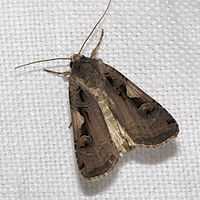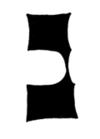Setaceous Hebrew character
| Setaceous Hebrew character | |
|---|---|
 | |
 | |
| Scientific classification | |
| Kingdom: | Animalia |
| Phylum: | Arthropoda |
| Class: | Insecta |
| Order: | Lepidoptera |
| Family: | Noctuidae |
| Genus: | Xestia |
| Species: | X. c-nigrum |
| Binomial name | |
| Xestia c-nigrum (Linnaeus, 1758) | |
| Synonyms | |
| |
The Setaceous Hebrew character (Xestia c-nigrum) is a moth of the family Noctuidae. It is found in the Palearctic ecozone. It is a common species throughout Europe and North Asia and Central Asia, China, Japan and Korea. It is also found in North America, from coast to coast across Canada and the northern United States to western Alaska. It occurs in the Rocky Mountains from Montana to southern Arizona and New Mexico. In the east, it ranges from Maine to North Carolina. It has recently been recorded from Tennessee.


The forewings of this species are reddish-brown with distinctive patterning towards the base; a black mark resembling the Hebrew letter nun (נ) with a pale cream-coloured area adjacent to this mark. The hindwings are cream-coloured.
Technical Description and variation
- See glossary for terms used
The wingspan is 35–45 mm.Forewing purplish grey or purplish fuscous with a leaden gloss; costal area at middle ochreous, merged with the bluntly triangular orbicular stigma: cell, a submedian basal blotch, and costal spot before apex purplish black; claviform stigma minute; reniform large, the lower lobe purplish; hindwing ochreous whitish, in female with the termen broadly fuscous.[1]
Biology
Two broods are produced each year and the adults are on the wing between May and October. This moth flies at night and is attracted to light and sugar, as well as flowers such as Buddleia, ivy and ragwort.
The larva is pale brown red-brown or green with obscure paler dorsal and subdorsal lines and a broad pale ochreous spiracular line. It feeds on a huge variety of plants (see list below). The species overwinters as a larva.
Recorded food plants
- Acer - maple
- Allium - onion
- Apium - celery
- Avena - oat
- Beta - beet
- Brassica
- Calendula - marigold
- Chrysanthemum
- Cichorium - chicory
- Cirsium - creeping thistle
- Comptonia - sweetfern
- Daucus - carrot
- Epilobium - rosebay willowherb
- Helianthus
- Hordeum - barley
- Hypericum - St John's wort
- Lactuca - lettuce
- Lamium - dead-nettle
- Lantana
- Linum
- Lobelia
- Lycopersicon - tomato
- Malus - apple
- Medicago - alfalfa (lucerne)
- Myosotis - forget-me-not
- Nicotiana - tobacco
- Photinia
- Pisum - pea
- Plantago - plantain
- Platanus - Oriental plane
- Primula
- Pyrus - pear
- Rheum - rhubarb
- Ribes - currant
- Rumex
- Senecio - groundsel
- Solanum - potato
- Solidago - goldenrod
- Spiraea
- Stellaria - chickweed
- Taraxacum - dandelion
- Thalictrum - meadow-rue
- Trifolium - clover
- Triticum - wheat
- Urtica - nettle
- Vaccinium
- Veratrum
- Viburnum
- Viola
- Vitis - grape
- Zea - maize (corn)
See Robinson, G. S. et al.[2]
References
- ↑ Seitz, A. Ed., 1914 Die Großschmetterlinge der Erde, Verlag Alfred Kernen, Stuttgart Band 3: Abt. 1, Die Großschmetterlinge des palaearktischen Faunengebietes, Die palaearktischen eulenartigen Nachtfalter, 1914
- ↑ "Robinson, G. S., P. R. Ackery, I. J. Kitching, G. W. Beccaloni & L. M. Hernández, 2010. HOSTS - A Database of the World's Lepidopteran Hostplants. Natural History Museum, London.".
- ^ The flight season refers to the British Isles. This may vary in other parts of the range.
- Chinery, Michael. Collins Guide to the Insects of Britain and Western Europe 1986 (Reprinted 1991)
- Skinner, Bernard. Colour Identification Guide to Moths of the British Isles 1984
External links
| Wikimedia Commons has media related to Xestia c-nigrum. |